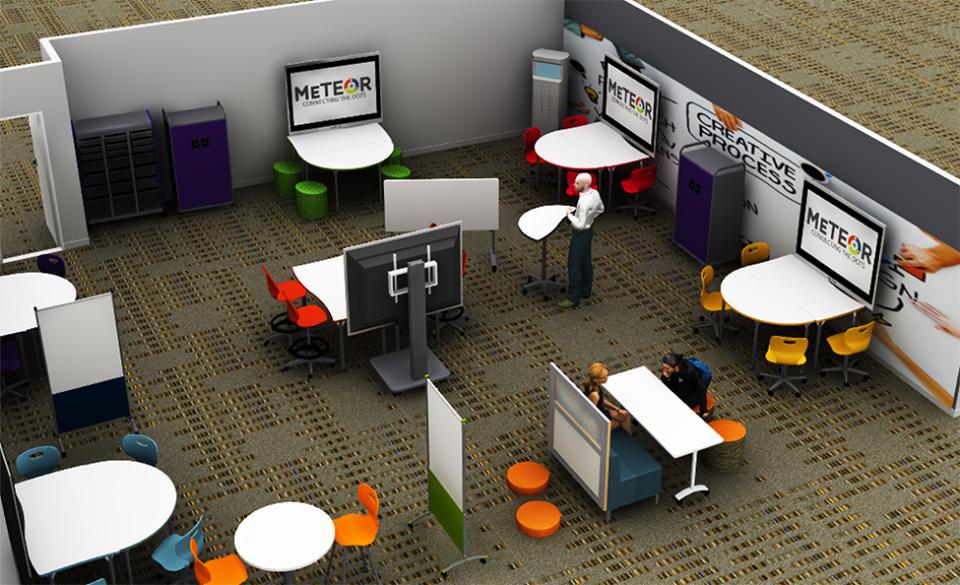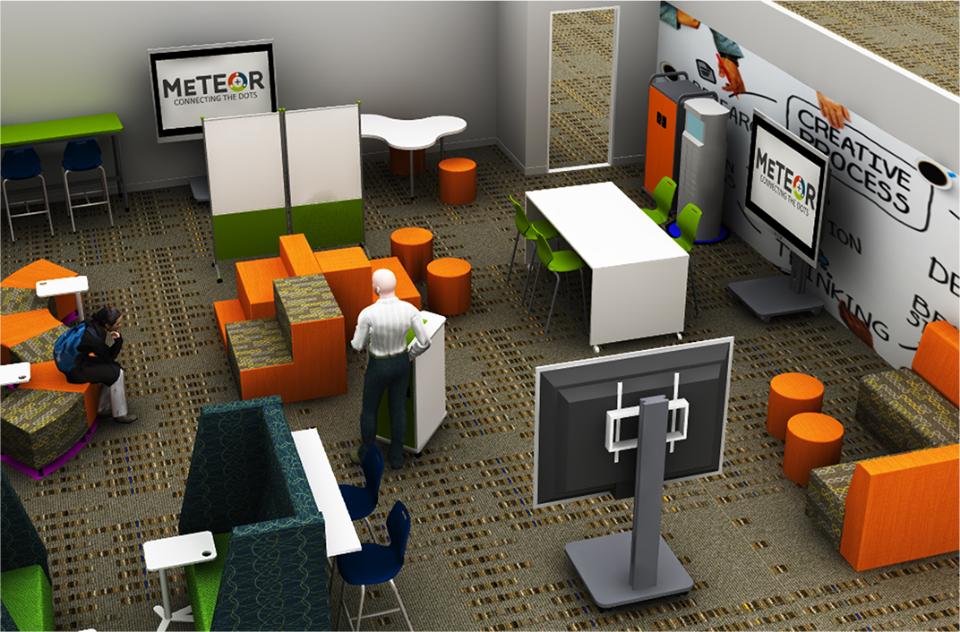Learning Spaces Initiative
About the Learning Spaces Initiative
One of the programs of the West Houston Institute (WHI) is the Learning Spaces Initiative (LSI), which serves as an active research project and practicum for the impact and implementation of pedagogies designed to draw upon and maximize the learning environment for the transformation of higher education and student success.
For more information about this initiative, contact Jordan Carswell, Interim Director, West Houston Institute.
Purpose of the Learning Spaces Initiative
To fully understand the LSI, it is necessary to first understand the overall vision of the WHI. The WHI was established in order to re-imagine and re-invent higher education. With this innovative vision, the institute’s programs and features were deliberately designed to ask what could and should be done to impact education rather than to assume the continuation of what is or has been done.
The LSI was developed with this mindset and the desire to consider the entire educational experience from the perspectives of both the instructors and the students. The LSI has developed two experimental classrooms as a testing ground to research the cumulative impact of environment, pedagogy, and technology on the student experience. These classrooms are not simply furnished differently, but rather designed to be utilized differently in order to provide individualized contexts for the students while simultaneously allowing the instructors to create a holistic class experience.
History & Development of the Learning Spaces Initiative
The LSI has been a part of the WHI’s program concept from the beginning of the Institute; however, the particular objectives of the LSI necessitated an extended concept phase. This developmental phase saw partnerships with and discussions between WHI staff, HCC faculty, PBK Architects Inc., Sony Electronics, and MeTEOR Education. Each partner provided both material and conceptual expertise in designing the two experimental classrooms of the LSI.
After developing the parameters of each room, MeTEOR Education compiled the modular furnishings for the two rooms. These furnishings were selected to enhance customizable modularity while simultaneously enabling the use of new pedagogical techniques and the ability to add or replace technologies without disruption of the fundamental character of the classrooms. Two distinct designs were created to accommodate focused research on increased or decreased technological presence and examine both a more formalized and more casual environmental impact on learning.
LSI Experimental Classrooms
The heart of the LSI is the experimental classroom. The development of the experimental classrooms reflects the recognition that the industrial training model, while effective for promulgating mass education in the 20th century, represents a methodology that both favors a certain type of learner and limits the ability to explore what is optimal rather than what is simply efficient.
As pedagogical theories have changed, the need to reflect on the learning environment must concurrently change. The two experimental classrooms were developed to unite the latest advances in pedagogical techniques, the newest technologies, and the most innovative understandings of learning spaces theory. While the two rooms share some common features for accessibility and modularity, they are distinct from one another in order to better explore a broader variety of possibilities.
Digital Fluency Room

The first experimental classroom is the Digital Fluency Room (DFR). The room is outfitted with carpeting that will impact the sensory experience of moving about the room and utilizes color theory to ensure a welcoming visual experience. Two of the four walls of the DFR are covered with whiteboard paneling to enable students and instructors immediate access to large whiteboard workspaces for ideating and organizing project activities.
The furnishings in the DFR consist of whiteboard tables, bringing whiteboard access to students in the center areas of the room or those needing access to whiteboards with less public visibility. These tables are all modular, and can be used individually, in smaller pods, or in larger groups (including an elongated format that would allow every student to share the same table space). In the smaller group formations, the table clusters can be designated by color bands around the tables. These color bands also allow for different tables to indicate designated project roles, sub-teams, or whatever other divisions will serve the learning goals.
The DFR is equipped with movable extendable power strips that allow students in any part of the room to have access to power for electronic devices. There is also a designated electronics cart for the storage of laptop computers or pads, ensuring that every student has a device to use if they lack their own or need to use an institutional device.
Perhaps the most distinctive aspect of the DFR will be the presence of six-touch capacitive monitors that allow instant touch access to the internet for research or presentation. Two of these monitors will be mounted on the fourth wall of the room, while the other four monitors will be mounted on mobile stands that allow for precise placement of the monitors that can be adjusted as the groups and layout of the room is altered.
The Coffeeshop

While the DFR is ideal for formal divisions and work teams, the second experimental classroom, the Coffeeshop, is themed for ad hoc or informal teamwork and activities. Like the DFR, the Coffeeshop is fully carpeted. It is also equipped with two whiteboard paneled walls and a number of portable whiteboards.
The Coffeeshop more overtly utilizes color theory, as the furnishings are more colorful. It also utilizes a much broader array of seating types, allowing learners to select between more traditional chair and desk formats or couches, stadium seats, or even ‘lilypads’ for floor seating. The Coffeeshop also includes wobble seating for those with sensory or anxiety concerns that allow student movement without disruption. The overall setting of the room is designed to invoke a relaxed environment akin to a coffee shop, clubhouse, or even living room setting.
At the same time, the furniture remains mobile and easily reconfigured to allow for both smaller pod work and open space full participation. The Coffeeshop also has a designated electronics cart to allow for wireless connectivity, and portable whiteboards for collaborative ideating regardless of the seating arrangements.
LSI Research Parameters
The LSI has an intentional research component. In keeping with WHI’s generative mindset, the purpose of the LSI is to gather data that can then be scaled across the system and beyond. An exact replication of the experimental classrooms is neither feasible nor warranted; however, the proper application of research data can be used to scale system-wide adjustments to classrooms’ color, furnishings, or layouts to improve the learning experiences in specific areas and functions.
Properly applied, this data can improve learning beyond the academic classroom as well. By properly researching the impact areas of the LSI, adjustments to corporate training protocols, pre-collegiate education, or informal learning organizations can be formulated. The LSI partnerships already established can serve as conduits that connect this research to the community while at the same time provide important community support for the continued research of the LSI.
LSI Protocols and Implementation
Because of the unique purposes and expectations surrounding the LSI experimental classrooms, a number of protocols are being established around its use. There will be certain requirements for the use of the classrooms. These requirements are somewhat broad, since the various types of research that are possible demand a certain flexibility. That said, these expectations must be adhered to in order to ensure an adequate and accurate collection of data.
Prior to using the experimental classrooms, faculty will be expected to complete an LSI orientation and training. This orientation will address the purposes of the LSI and its unique features, while the training will introduce ways to directly apply those same features to the pedagogical process. The training will also address the development, recording, and transmission of research data for the rooms.
After a faculty user has been trained, both the faculty member and the students must consent to the terms of research, which may include recording the class audibly and/or visually, submission of faculty training notes, and recording of impacts on attendance, participation, and retention. This consent will be variable depending on the specifics of the research, but must be obtained in order to ensure the ability to disseminate and fully utilize the research data. Faculty will have access to an electronic tablet dedicated to the LSI room for the recording of the research data and the ability to review in real-time specific metrics and student impacts.
The LSI experimental classrooms will be available for instructors of any discipline. In no case will an instructor have all of their courses assigned to the LSI rooms. To the contrary, users of the experimental classrooms will ideally teach a second section of the same course in a conventional or active-learning classroom. This will allow for a more accurate and meaningful assessment of how the LSI affects the pedagogical process.
Access to the experimental classrooms will follow a four stage process. First, the faculty must complete the LSI orientation and training. Next, the faculty member should schedule a one-time use of the classroom for one of their classes to further familiarize themselves with the actual use of the room in a live setting. Third, faculty members will work with WHI staff to coordinate a research protocol for one of their courses. This protocol will establish parameters for research and both benchmarks and means of assessing the impact of the LSI in contrast to the control group of a more conventional classroom.
Current Conditions and Next Steps
Currently, the LSI experimental classrooms are furnished and designed. Touch capacitive monitors are received and available, and communications with the project partners has been maintained. MeTEOR Education has committed to providing a recorded video and an in-person training session over the options and possibilities for using the special furnishings and incorporating them into pedagogy. The recorded trainings must take place on-site, so they have not been completed yet.
While the monitors have been received, both experimental classrooms need to have monitors hung in designated locations. The remaining touch-capacitive monitors will need to be mounted on a mobile stand as well. The equipment for the electronics cars (tablets and/or laptops) need to be obtained and designated for exclusive use in the experimental classrooms. Finally, a designated research tablet will need to be obtained for each room. This research tablet will likely be wall mounted near the entrance(s) in order to provide immediate access upon entry and closing access upon conclusion of a class session; this mounting will need to be done after obtaining the tablets.
While there is physical work to be completed, once on-site activity is authorized the finalization of the physical equipping of the rooms should be completed in short time. Similarly, since MeTEOR Education has already agreed to the training of faculty and staff, initial training protocols can likewise be completed quickly. With this in mind, the projected availability for singular events and one-time classes (assuming on-site access in the summer) is by mid-Fall 2021.
Contact Us
Jordan Carswell
Director, West Houston Institute
